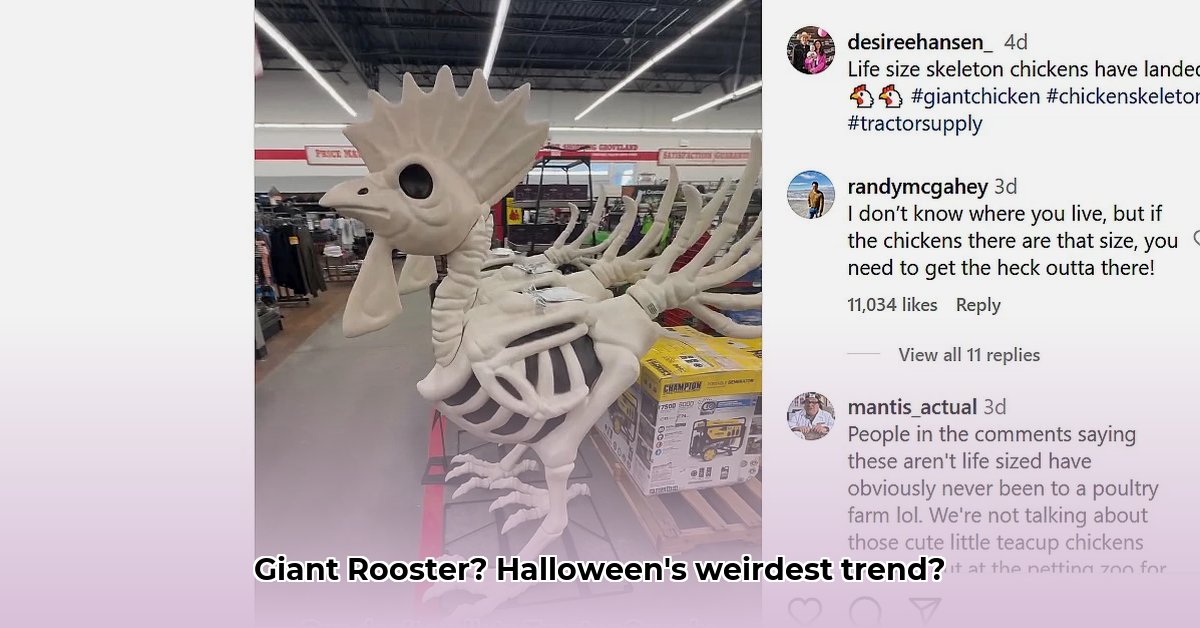
The Unexpected Rise of the Giant Rooster
This Halloween, a surprising trend has taken flight: Tractor Supply's six-foot-tall skeleton rooster has become a viral sensation, rapidly selling out across the country. This isn't your average pumpkin or ghost; it's a giant, quirky poultry-themed decoration that's sparked a conversation about the evolving landscape of Halloween décor. But what's behind this unexpected craze? Is it a fleeting fad or a sign of broader shifts in consumer preferences? For more information on the rooster's origins, check out Tractor Supply's website.
The rooster's popularity echoes that of other oversized Halloween decorations, like Home Depot's giant skeletons. But this trend raises several key questions: Is there a growing market for jumbo-sized farm animal Halloween décor? How sustainable are these large-scale decorations, and will consumers increasingly prioritize eco-friendly alternatives?
What's driving this demand? While definitive data is still emerging, the rooster's unique size and design, coupled with its availability through a well-established retailer, likely contributed to its viral spread. Social media played a significant role, with countless photos and videos showcasing the rooster in various festive settings. The substantial price point—approximately $300—suggests a market segment willing to invest in unique and eye-catching decorations. This begs the question: will this trend continue, and will other retailers jump on the bandwagon with similar oversized animal decorations?
Analyzing the Market and its Implications
The six-foot rooster's success has implications for several stakeholders:
| Stakeholder | Short-Term Impacts | Long-Term Strategies |
|---|---|---|
| Tractor Supply | Increased sales and brand awareness; potential supply chain issues. | Expand product lines; explore sustainable materials; adjust pricing based on demand and production costs. |
| Manufacturers | Increased demand for large-scale Halloween decorations; potential for innovation in materials and design. | Focus on eco-friendly manufacturing; develop new designs to capitalize on the new trend. |
| Consumers | Increased interest in unique and oversized Halloween decorations; growing awareness of environmental impact. | Demand more sustainable and ethical products; explore creative DIY options. |
| Environmental Groups | Increased scrutiny of the environmental impact of plastic decorations. | Advocate for sustainable manufacturing practices; promote waste reduction and responsible disposal methods. |
Potential Risks and Mitigation Strategies
While the current trend is positive, several challenges exist:
| Risk Factor | Probability | Impact | Mitigation |
|---|---|---|---|
| High Production Costs | Moderate | Moderate | Explore lower-cost, sustainable materials; optimize manufacturing processes. |
| Environmental Concerns | High | High | Transition to recycled or biodegradable materials; promote responsible disposal. |
| Changing Consumer Demand | Moderate | Moderate | Diversify product offerings; explore seasonal and year-round décor options. |
| Negative Customer Reviews | Low | Moderate | Enhance quality control; offer warranties and customer service support. |
The Path to Sustainable Spooktaculars
The rooster's immense popularity highlights a growing need for sustainable Halloween decorations. The environmental impact of mass-produced plastic items is significant. Consumers are increasingly seeking eco-conscious alternatives. This presents both a challenge and an opportunity for manufacturers and retailers to explore more sustainable materials and production processes.
Moving Toward Eco-Friendly Alternatives: A Three-Step Plan
Repurpose and Upcycle: Reimagine existing materials. Old clothing can become costumes, and discarded wood can become spooky structures. Get creative!
Embrace Natural Materials: Fallen branches, leaves, and pumpkins offer a rustic and biodegradable option.
Seek Biodegradable Alternatives: When purchasing new materials, prioritize those that decompose without harming the environment.
By embracing sustainable practices, we can enjoy a spooktacular Halloween without sacrificing the planet's well-being. The six-foot rooster, while a fun trend, serves as a reminder of the importance of considering the environmental impact of our consumer choices. Further research into the specific environmental footprint of these large-scale decorations is crucial in guiding future production and consumption patterns. The future of oversized Halloween décor depends on striking a balance between festive fun and environmental responsibility.